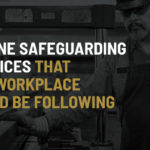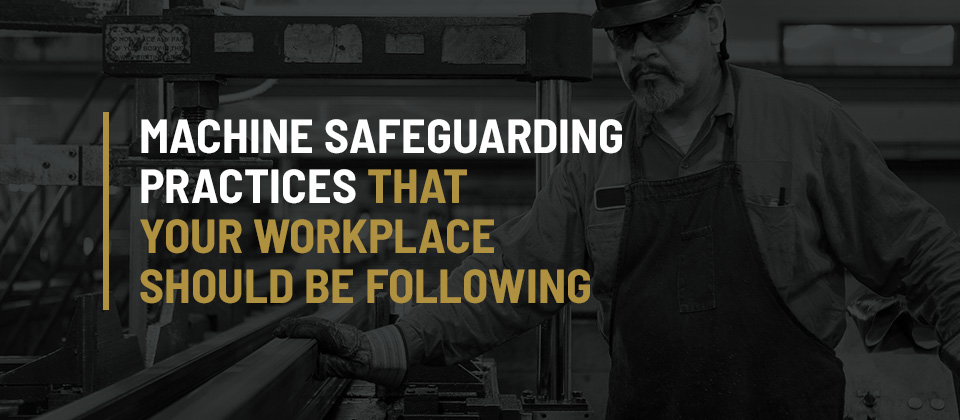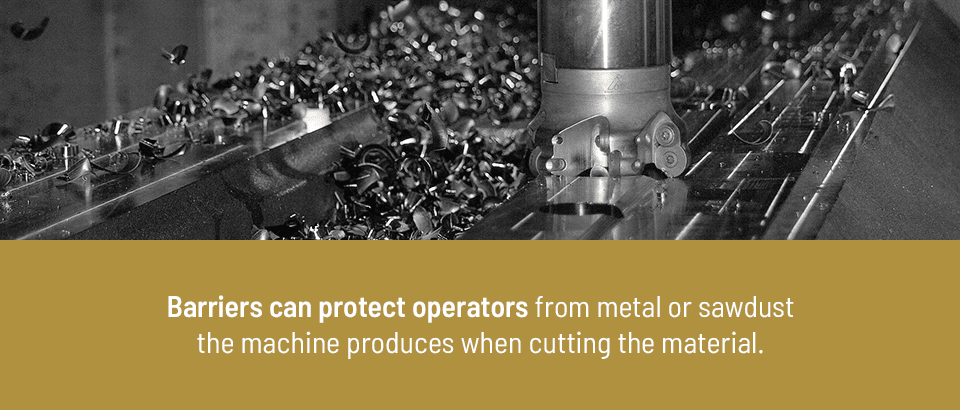Machine Safeguarding Practices That Your Workplace Should Be Following
Machines improve efficiency and productivity by increasing the amount of work that individuals can do. Machinery can also exert more power than any person could. Most workplaces use machinery to get the job done. But, sometimes safety precautions do not happen and injuries occur. If you use machinery at your workplace, you should learn about the methods of safeguarding and the types of guards used. Then, you can see if your workplace follows safety guidelines as it should or if you have a hazardous work environment.
Moving Machine Hazards and How They Cause Injury
Moving machinery poses multiple hazards for workers. The potential injuries that could occur include amputations, blindness, burns or crushed fingers. This machine hazards list covers many elements of equipment that can cause injuries, including:
1. Point of Operation
The point of operation refers to the components of the machine that perform a desired task. For instance, on a cutting tool, the blade is the point of operation. Different machines have different point of operation hazards. Some common dangers at the point of operation include:
- Pinch points where any moving parts come together and can cause pinching of fingers.
- Shear points where blades meet can cut or tear the skin or cause amputations.
- Crush points where moving parts meet or move against stationary parts and can crush fingers, potentially leading to amputations.
- Pull-in points where equipment pulls in materials and can drag clothing or fingers into the equipment.
- Thrown materials that can cause eye injuries, blindness or lacerations on impact.
These parts of the equipment require protection from fingers, clothing and other tools to keep these from getting into the equipment and causing injury. Guards to cover these points of operation can prevent severe injuries to the operator.
2. Power Transmission
Power transmission apparatuses can also pose dangers. These components transfer mechanical power throughout the machine. Therefore, they contain numerous moving parts such as cogs, flywheels, gears, pulleys, belts, chains, spindles, connecting rods and couplings. These moving parts can present hazards to fingers and hands that could get caught inside. Loose clothing could also draw hands into the machinery. As with the operation parts of machinery, the power transmission system should not have unguarded or exposed moving components.
Another crucial feature of power transmitters is the ability to shut off the equipment in an accident. Shut-off controls must always be within easy reach of the operator.
3. Electrical Hazards
The electrical components pose an electrocution threat. Workers receiving shocks, no matter how minor, indicate a problem with the electrical parts of the machine.
The threat of shock or electrocution increases with loose connections, non-grounded machines, improperly fused power supplies or installation that does not meet the National Electric Code or National Fire Protection Association requirements.
4. Auxiliary Parts
Any auxiliary parts that move could present the same dangers to workers as points of operation or power transmission apparatuses. Moving gears or other components could entrap fingers or hands, leading to cuts, pinches or crushes. Any exposed moving auxiliary parts need safeguards to protect workers.
5. Non-Moving Part Hazards
Workers also face possible harm from non-moving components of the equipment. For instance, hearing damage may occur from equipment that is too loud or operated continuously for too long when workers don’t have hearing protection.
Harmful substances released into the air could sicken workers who inhale them, such as sawdust or metal dust. Respirators or other types of lung protection help you avoid these types of hazards where machinery operation presents them.
Machine Safeguarding Requirements
The Occupational Safety and Health Administration (OSHA) places requirements on the types of machine safeguards used. These guidelines ensure that the safeguarding methods used will be effective in protecting you from injury at your workplace. Your employer must follow all applicable OSHA standards, and may face penalties for violations. OSHA has certain guidelines for the types of safeguards implemented with various machines.
The agency also lays out many general requirements for machine guards in standard 1910.212. Installers must affix guards to the equipment or secure them in another location if the former option is impossible. Additionally, the guards should protect without creating new problems with operation or hazards. In other sections of 1910, and in standards for construction, maritime and agriculture industries, the agency specifies guarding requirements for specific types of machinery, from woodworking machines to hand tools.
OSHA’s general guidance for machine guards states that guards should:
- Prevent contact: The guards installed on machines must prevent worker contact with the moving parts of the equipment. These include protection against the power transmission, point of operation and other moving components of the machine.
- Be secured: The guards must have a secure installation on the machine or in a location that prevents them from dislodging during operation. Secure attachments also prevent accidental removal, which could increase injury risk.
- Allow for safe lubrication: To keep machinery operating smoothly, workers may occasionally need to lubricate the moving parts. Whenever possible, the safeguards should permit access for lubrication without requiring removal.
- Prevent falling object hazards: Objects falling into the machine can become projectiles. Any type of guard on the machine should prevent both people and foreign objects from falling inside the mechanism. Safeguards should protect against any objects falling into the machine.
- Do not interfere with the machine: The guards should not interfere with the normal operation of the machine. All workers who use the machine should feel comfortable with the guards in place and accomplish their job efficiently.
- Do not create new dangers: As guards against hazards, the safeguards used cannot present new dangers to users or those in the area. Therefore, the structure of physical guards cannot have shear points, sharp edges or rough surfaces that could cause cuts or other injuries.
The Two Types of Safeguarding Methods
Safeguard devices protect users from injury by creating barriers between you and the dangerous piece of equipment. Two main methods of safeguarding machines include physical guards and devices. Combining these on a machine enhances safety by providing redundant protection. Though, technically, any individual guard or device could be used alone for protection on a machine.
Guards
Physical guards create barriers to the moving parts of machinery. They have four main forms, each with distinct advantages and disadvantages that suit them best to particular applications. These guard types include:
- Fixed Guards: These provide a fixed barrier to moving parts. They may require removal for maintenance or repairs. If a machine guard is missing or needs repair, you should read the manual thoroughly and ask for help from an experienced repairman.
- Adjustable Guards: These guards allow greater flexibility for the machine to accommodate different material sizes. However, they could allow for hands to enter the hazard area during adjustments.
- Interlocking: Interlocking guards connect to the machine’s power source. When the worker opens the guard, the machine cuts off automatically. These types of guards require careful adjustments and regular maintenance.
- Self-adjusting guards: Only allow the material through the guard during operation. These types of guards are often commercially sold and readily available. However, they may interfere with visibility.
Devices
Devices may stop the machinery if they detect non-materials in the danger area. Or, they may require operators to use two hands before using the machine. Many devices require calibration to ensure they correctly shut off the machinery if engaged. Some common types of safety devices used on machinery include:
- Electromechanical: A bar or probe drops down into the machine. If something blocks it from moving a specified distance, such as a hand in the danger area, it will not allow the machine to turn on.
- Gate: Gates interlock with the machinery to prevent operation unless the gate is in place, stopping entry into the dangerous area of the machine.
- Photoelectric: Photoelectric devices have similar operation to electromechanical devices, except for photoelectric devices use light fields. If the light beam is broken, the machine stops and cannot restart until the area clears.
- Pullback: These devices physically pull the operator’s hands out of the danger area when the machine starts.
- Radiofrequency: Similar to photoelectric devices, radiofrequency mechanisms stop the machine before the operator can reach the danger zone.
- Restraint: These devices hold the operator’s hands safely out of the way during the use of the machine. Unlike pullback devices, restraints do not allow as much movement of the operator’s hands.
- Safety trip controls: Pressure bars on the machine stop operation if the worker leans forward or trips.
- Two-hand control: The operator must use a control button during the close cycle of a machine to keep their hands safely away from the point of operation.
- Two-hand trip: The machine requires two hands to start operation, which keeps them at a safe distance from the danger zone during machine operation.
Which safety devices a machine uses depend on the type of operation and its ability to stop when a safety mechanism trips.
The Six Types of Machine Guarding
Machine guarding falls into six main categories. As seen, two are guards and devices. However, other methods of ensuring operator safety go beyond these two standards. While guards and devices should be in use, adding other safeguards improves the safety of operators and everyone in the surrounding area.
1. Guards
Guards provide physical barriers against operator hands or fingers entering the danger zone. The benefit of physical guards is their ability to protect with less concern about failure and less maintenance than some safety devices.
2. Devices
Safety devices provide an additional method of protection against danger when using machines. These can stop machinery before an emergency occurs, which lowers the chances of operator injury.
3. Automated Feeding
Automated feeding and ejection devices do not require the operator to use their hands to put materials into the machine or pull them out. These means of machine guarding help to keep the operator’s hands far from the point of operation.
4. Machine Location
Putting machinery in an isolated location away from excess distractions and other non-operators protects those in the area from possible flying debris. Plus, the operator does not have distractions that could cause safety problems.
5. Barriers Around Machines
Shields around the danger area to protect against flying debris can provide an additional level of protection. For instance, these barriers can protect operators from metal or sawdust the machine produces when cutting the material.
Visual barriers may also be around the machine area to protect those without proper PPE from entering the area during machine operation. Simple signage, gates or floor markings can indicate a work zone for machinery that non-operators should stay out of.
6. Material Holding Tools
Tools used to hold materials during feeding can keep hands safe. Often, these pair with restraint devices that keep hands away. The tools allow for the operator to reach deeper into the machine without putting their hands at risk of entering the danger zone.
Safety Precautions to Follow
Employers have a responsibility to maintain equipment and provide guarding on machinery. They must also encourage safety precautions in the workplace.
Personal Protective Equipment (PPE)
All employees should have access to and use PPE. The type of PPE required depends on the machinery. For instance, machines that produce high levels of noise necessitate ear protection. Equipment that could produce flying parts requires eye protection. For anything that could pose a breathing problem, from fumes to dust production, may require a respirator or filtering mask.
Employers also have a responsibility to train workers in PPE use, maintain the PPE and create an environment that makes PPE use acceptable and expected.
Equipment Safety Training
Workers who use machinery need regular training and educational updates on safely using the equipment. This safety training will update the workers on how to properly use the equipment, safety guidelines to follow for the machine’s specific operation, and how to identify issues that may require attention.
Safety Rules for Machinery Areas
Workplaces that operate machinery should have posted safety rules for all workers to follow. The following are some common rules that should be part of the posting:
- Never operate machinery unless fully trained on the equipment.
- Check that machinery guards and safety devices are in place and intact before and after using the machine.
- Do not leave machinery unattended.
- Always wear appropriate PPE for safety.
- Keep hair, clothing, hands, feet and accessories pulled back and out of access of the machine while using the equipment.
- Move all tools away from the machine after making repairs or adjustments before restarting the equipment.
- Never use compressed air for cleaning machinery or yourself.
Other safeguards that apply to specific situations in your workplace, such as guidelines regarding hazardous chemicals, should also appear in the safety rules. If you don’t see safety rules posted, ask your supervisor or employer to put them up to ensure that everyone has access to the information.
Contact Us at Frommer D’Amico If Your Workplace Does Not Follow Principles of Machine Guarding
If machinery caused you an injury at work, contact us at Frommer D’Amico. We offer free case management for workers’ compensation claims. Our goal is to get each client the help their case deserves. To do so, we make ourselves available 24/7 and provide personalized attention to each case. Tell us about your case, and we can provide you with a free consultation and case management if you choose to partner with us.





